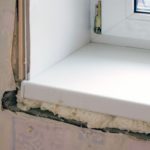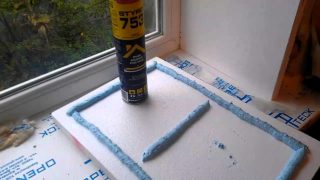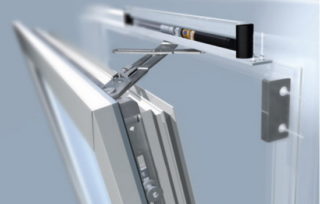Window structures made of plastic are present in almost all multi-storey buildings. Double-glazed windows are popular for their reliability, good sound and thermal insulation, long service life and attractive appearance. But they also have their drawbacks - in winter, windows can freeze due to improper operation or lack of sufficient care. Windows are insulated in several ways, including independently, using various materials and methods.
Reasons and places of freezing
Blowing and freezing windows in winter can occur for various reasons. Often the problem is the temperature difference in the street and in the house. Double-glazed windows do not have time to heat from the side of the room without the formation of condensate. If the outside temperature drops, the condensate outside the window turns into an ice layer with a thickness of at least 1 mm. An increased level of humidity also badly affects the condition of the windows.
In this case, we are talking about poor ventilation, when warm air is not automatically removed using the ventilation holes. If they are clogged, the indoor microclimate is kept low and causes increased humidity. Thermal insulation of plastic windows can improve the situation.
If the installation of windows was carried out in violation of the technology, this can cause the formation of condensation. Most often, it is formed in the corners, at the junction of glass and glazing bead, turning into water in the warm season or ice during frosts.
There are some of the most problematic areas that need to be given special attention. Casement windows may sag due to poor fittings. If they do not adjoin enough to the frame, cracks are formed through which air from the street enters. Because of this, the glasses are very cooled, condensation appears on them, as a result, they begin to freeze. When replacing windows, the deepening of the frame inside the opening often becomes the cause of freezing, because of this the room can blow out.
The thickness of the opening is normally 120 mm, the approximate depth of at least 70 cm. For this reason, warm air from the battery does not fall on the glass. As a result, an unheated area is formed in the window sill area; in severe frosts, the condensate on it completely freezes. To prevent problems, it is better to choose windows with a thick profile, this will help reduce the recess.
The wide window sill in the room can negatively affect air circulation. Potted flowers and curtains can block the flow of heat from batteries or radiators.
Insulation of plastic windows
Insulation of plastic windows helps to create a comfortable temperature in all areas of the house or apartment. For this purpose, silicone, insulation and special seals are used. The insulation work itself is divided into several stages:
- thermal insulation of slopes;
- adjustment of accessories for double-glazed windows;
- replacement of the seal and other parts.
- Slope insulation
- Hardware Adjustment
- Seal replacement
With proper insulation with your own hands or with the help of specialists, you can create a comfortable mode in the room. These measures help prevent the formation of dampness and mold, as well as save energy.
Slope insulation
You can insulate the slope with the help of mounting foam, which fill the space between the wall and sheets of drywall. Mineral wool, gypsum boards, polyurethane foam, basalt fiber, silicone or polyurethane foam are used as insulation.The most commonly used combination of silicone and drywall. Before the procedure, check the quality of processing of window blocks. Places where the foam is flooded poorly, there will be a draft that can blow through the windows.
After measuring the slopes, you need to cut several blanks from drywall and insert them into the slots. During the pouring process, side slopes are fixed to the wall with masking tape to prevent sheet deformation. The joints between the window blocks and drywall are treated with sealant, the window slopes are also insulated from the outside. In addition, silicone sealant must be applied to the foam to prevent exposure to weather conditions.
Seal Replacement
Insulation of the windows of the house from the outside includes the replacement of gaskets, which can be made independently or purchased ready-made. To create a heater, sew pillows with your own hands and fill them with loose and dense material, such as rice or sand. Each pillow is installed on the windowsill.
A dense denim that can handle the cold air will be the best option. The black material looks much better compared to the color and does not spoil the appearance of the windows. After removing the old sealant, the surface is cleaned of dirt and dust, only then can the new material be installed in compliance with all necessary conditions.
Clip setting
The clamp is adjusted twice a year, increasing its degree on the eve of the winter period and decreasing after the onset of heat. To adjust the clamp from the inside, oval cylinders, the so-called trunnions, are found at the end of the sash. The clamping force is adjusted by moving the holes on the frame or by rotating the trunnions. To increase the gain, the eccentric is turned by the protruding part to the inner side of the window opening. To reduce it, perform the procedure in the reverse order, turning the pin with the protruding side out.
Sash position adjustment
If the sash touches the edges of the frame, then the fittings are loose or deformed. This happens when the window is often open - the fittings are damaged due to the severity of its wings. Also, a problem may arise due to a sharp opening and closing of windows - this leads to a weakening of fastenings and deformation of parts. To return the sash to its correct mode, you will need:
- turn the sash to the lower canopy or lower the structure down completely if it touches the frame from the upper end;
- raise and rotate the element towards the upper hinges if the sash touches the frame with the lower end on the handle side;
- shift the structure towards the hinges, turn the sash to the lower or upper canopy if it touches the frame in the middle of the end part.
To adjust the frame, you need to turn the bolts with the hexagons in the upper part of the window and on the lower canopy.
Adhesion of heat insulating film
Before starting work, it is necessary to exclude the presence of cracks that may be present in wooden frames and doors. They are sealed with silicone or sealant.
Next, the inner sides of the frames or the door are washed, treated with degreasers and double-sided tape is glued around the perimeter. The film is divided into uniform parts, taking into account the size of the frame, leaned against the surface of the adhesive tape, previously slightly stretched. In this case, it will be fixed in the right position and will last for a long time.
Prepare for warming should be in advance so that the process does not drag on and the procedure is as comfortable as possible. It’s better to choose a dry and warm day for her. In winter, it will be difficult to install a protective coating and film. Some components are used only at a certain temperature.All stages of insulation must be studied before the procedure, taking into account even the smallest details. In this case, the windows will not be blown out by cold air, the rooms will retain the perfect microclimate.










